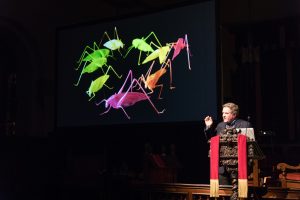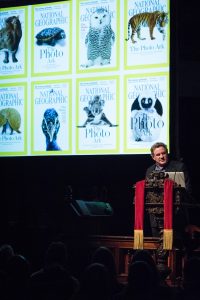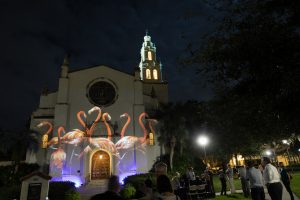Earth is currently experiencing the worst rate of species extinction since the loss of the dinosaurs 65 million years ago. The extinction of animals is a natural phenomenon relative to the theory of natural selection, but it is meant to occur at a “natural background rate” of around 5 species per year. However, scientists have predicted that we are currently losing species at a rate 1,000 to 10,000 times the background rate. Nature’s destiny appears to be quite frightening, with nearly 30 to 50 percent of all species being endangered by the middle of this current century.
 Joel Sartore is a photographer, author, endangered species advocate, and National Geographic fellow who is using his camera lens to send a powerful message through the project he calls the “Photo Ark.”
Joel Sartore is a photographer, author, endangered species advocate, and National Geographic fellow who is using his camera lens to send a powerful message through the project he calls the “Photo Ark.”
The Photo Ark is an ambitious project committed to documenting every species of animal currently in captivity—aiming to inspire the world to not only care about these animals but also protect them for generations to come. To this day, Joel Sartore has visited 40 countries and has captured photos of 6,000 species, only half of the number he hopes to reach in his quest to create a legendary archive on global biodiversity.
“No matter its size, each animal is treated with the same amount of affection and respect. The results are portraits that are not just stunningly beautiful, but also intimate and moving,” said the project’s founder. This 25-year project has the potential to change the mindsets of a lot of people; hopefully society will begin to recognize the true beauty of our world’s organisms.
 Rollins was lucky enough to host Joel Sartore on Oct. 14 in Knowles Chapel, where the community and student body learned about this extinction crisis first-hand from the man who hopes to inspire millions. His photos were even projected onto the front of the chapel after the presentation. The image of the highly endangered Golden Snub-nosed monkey plastered on the front of a Rollins building amidst a foggy sky and a full moon was something for the books.
Rollins was lucky enough to host Joel Sartore on Oct. 14 in Knowles Chapel, where the community and student body learned about this extinction crisis first-hand from the man who hopes to inspire millions. His photos were even projected onto the front of the chapel after the presentation. The image of the highly endangered Golden Snub-nosed monkey plastered on the front of a Rollins building amidst a foggy sky and a full moon was something for the books.
Throughout the presentation, Joel let the audience into his personal life. Although he began with a comedic introduction on his background and family, he changed the atmosphere. He informed the crowd on his wife’s diagnosis of breast cancer just ten years ago. Although this was devastatingly difficult for his family at the time, Joel was struck with the reality that life is short and the people we care about can be taken from us extremely easily. This diagnosis sparked the initial idea of the Photo Ark in his mind—the animals within our world can and are being taken from their environment far too soon, all because of human causes.
Joel’s wife, Kathy, pushed through her chemo and radiation therapy, beating cancer and remaining a stable supporter in Joel’s life. As her health improved, Joel was able to travel to nearby zoos, capturing their animals on black and white backgrounds. These solid backgrounds make the animal stand out—viewers have no choice but to simply recognize the animal’s detailed beauty.
The first animal Sartore chose to photo was a naked mole rat, an animal whose importance is completely unrecognized by society. However, these animals are essential to the future of medicine, because they are immune to cancer and and the sensation of pain from injury or inflammation. If these simple breakthroughs exist in naked mole rats, imagine what exists in the heart of the Amazon Rain Forest.
 Society loves to focus on the classic megafauna—elephants, tigers, polar bears—also known as the big, loveable, animals that are too adorable to ignore when on the brink of extinction. However, Sartore’s project aims to push people to open their hearts up to the smaller, unknown, “less attractive” species that are critically endangered. This includes the amphibians, reptiles, birds, and rodents that struggle to gain recognition as being highly important to the success of many ecosystems and their biodiversity levels. Together, we must see each animal as equal contributors to society. The Florida Panther going extinct should be more detrimental than your iPhone 7 shattering.
Society loves to focus on the classic megafauna—elephants, tigers, polar bears—also known as the big, loveable, animals that are too adorable to ignore when on the brink of extinction. However, Sartore’s project aims to push people to open their hearts up to the smaller, unknown, “less attractive” species that are critically endangered. This includes the amphibians, reptiles, birds, and rodents that struggle to gain recognition as being highly important to the success of many ecosystems and their biodiversity levels. Together, we must see each animal as equal contributors to society. The Florida Panther going extinct should be more detrimental than your iPhone 7 shattering.
Today, only 75 red wolves are still alive. Only 250 Philippine crocodiles remain. Four Northern White Rhinoceroses are alive and well, but zero Columbia Basin Pygmy rabbits currently roam our Earth. As the numbers of species continue to dwindle, we must make a change in our living habits and recognize the negative impact we humans have on our surrounding brothers and sisters who deserve life just as much as we do. There is still time to save many of these endangered species; we have to start acting now.






Be First to Comment